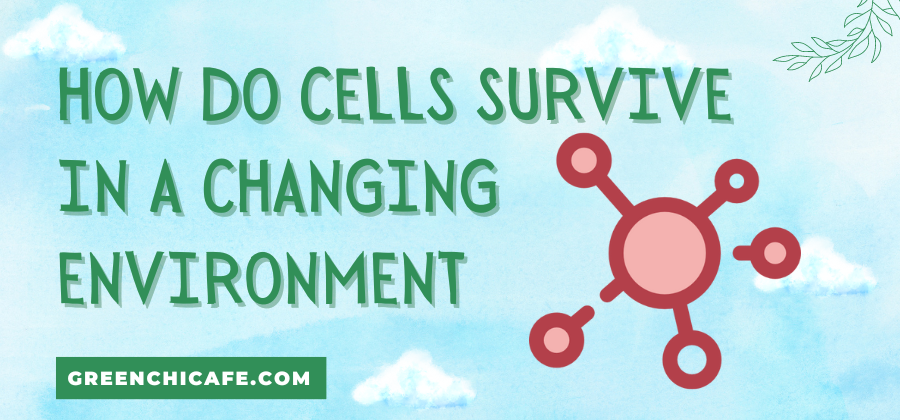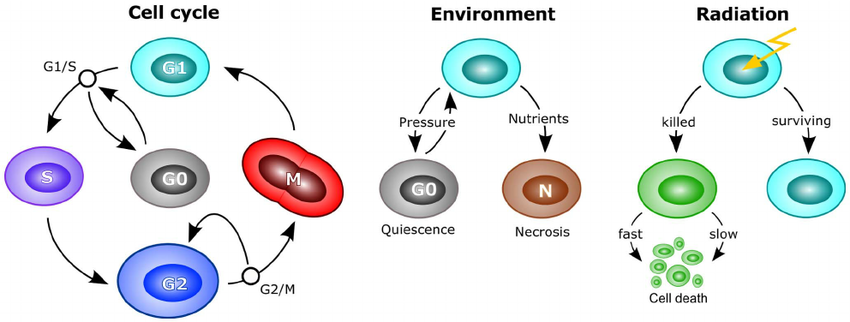Cells are complex biological systems that require careful regulation to function properly.
Cells have a remarkable ability to adapt and thrive in an ever-changing environment.
This article explores how cells maintain homeostasis and equilibrium to survive in dynamic conditions.
How Do Cells Survive in a Changing Environment?
Cells have a remarkable ability to sense changes in their environment and respond quickly to maintain homeostasis and equilibrium.
This article explores the strategies cells use to adapt and thrive in dynamic conditions.
Key Points
- Cells carefully regulate osmosis, temperature, pH, and waste removal to preserve internal stability.
- Receptor proteins and signaling pathways constantly monitor conditions and transmit information inside cells.
- Stress responses like boosting antioxidants and altering gene expression help cells survive challenges.
The Fundamentals: What Cells Need to Survive
To carry out basic functions, cells require water, nutrients, and the removal of metabolic wastes.
The cytoplasm provides an aqueous environment where most molecular interactions take place.
Cells maintain a delicate pH balance and must have nutrients available for energy production.
They also require efficient waste removal systems to avoid toxicity.
Even single-celled organisms have specialized parts like contractile vacuoles to expel excess water and maintain homeostasis.
How Do Cells Maintain Equilibrium?
Though conditions fluctuate, cells utilize various strategies to preserve internal stability.
Osmoregulation allows cells to control water balance by altering the concentrations of solutes like salts and sugars.
Thermoregulation preserves optimal temperatures through methods like vasoconstriction.
Additionally, cells leverage buffering systems to resist changes in pH.
Negative feedback loops work to reverse deviations and restore set points.
Cells also have adaptation mechanisms that provide long-term adjustments to new environments.
How Do Cells Respond and Adapt to Stressors?
When confronted with stressors like toxins, heat, and microbial pathogens, cells initiate rapid protective responses.
These include boosting levels of chaperones to help proteins fold properly and ramping up antioxidant defenses to mitigate oxidative damage.
Cells may also activate or repress relevant genes through epigenetic modifications.
For example, a histone deacetylase called SIRT1 senses stress signals and triggers downstream survival pathways.
Cells deprived of key nutrients like glucose or amino acids also have elaborate mechanisms to find alternatives, like using fatty acids or recycled amino acids.
What Are Some Ways Cells Preserve Energy?
Cells carefully regulate metabolic expenditure to avoid energy crises.
During scarcity, non-essential processes like cell growth and proliferation may be halted.
Cells may also undergo metabolic changes to economize energy usage, such as switching from aerobic respiration to anaerobic glycolysis.
Some cells enter hypometabolic states involving channels that leak ions to maintain membrane potential with minimal energy expenditure.
Cells can even leverage circadian rhythms to carry out energetically demanding processes during optimal times.
How Does Information Flow Within Cells?
Elaborate communication networks allow cells to quickly transmit status updates to appropriate destinations.
Signaling cascades amplify signals and spread information rapidly to multiple targets.
Scaffold proteins and molecular complexes bring key players together to facilitate signaling.
Components like G proteins, second messengers, and protein modification help convey signals inside cells.
Feedback loops ensure signals are terminated when appropriate.
Efficient transmission of cellular information enables coordinated responses.
Do Cells Communicate With Each Other?
In multicellular organisms, cells cooperate and coordinate their activities.
Adhesion proteins physically tether cells together while gap junctions allow direct transfer of molecules between adjacent cells.
Paracrine signaling involves the local secretion of substances like cytokines that act on neighboring cells.
In endocrine signaling, hormones released into the bloodstream travel to distant cells.
Neural signals can also propagate through synapses.
Cell-to-cell communication enables tissues and organs to function in synchrony.
How Do Stem Cells Remain Flexible and Responsive?
Stem cells strike a balance between stability and plasticity using regulatory networks governed by “master regulators” like Oct4, Sox2, and Nanog.
Actively dividing cells use mechanisms like an abbreviated cell cycle to remain poised for action.
Quiescent stem cells leverage epigenetic modifications to silence genes related to differentiation while maintaining multipotency programs.
This combination allows them to quickly activate relevant genes when mobilized to repair damaged tissues.
Environmental signals play a key role in determining cell fate.
What If Damage Accumulates?
While cells vigorously defend homeostasis, sometimes insults exceed repair capacities.
As a last resort, programmed cell death mechanisms like apoptosis offer a controlled means of elimination.
Apoptosis neatly packages cellular contents for efficient removal and recycling.
Dying cells also release “find me” signals to attract phagocytes that engulf and eliminate cell corpses before they rupture and cause inflammation.
Cell death thus promotes organismal health.
Can Cells React to Changes in the Environment?
Yes, cells can sense and react to changes in their environment.
They have specialized mechanisms to detect alterations in conditions like temperature, pH, oxygen levels, osmolarity, and nutrient availability.
Receptor proteins on the cell surface bind signaling molecules that relay information about the extracellular space.
Inside the cell, levels of metabolites provide live updates on metabolic status.
Any deviations from optimal ranges trigger compensatory responses aimed at restoring homeostasis.
Cells are extremely sensitive and can react to minute fluctuations in their surroundings.
Their adaptive capabilities allow cells to mount appropriate responses and survive in changing environments.
How Do Cells Adapt to Change?
Cells leverage both short-term and long-term strategies to adapt to change.
In the short term, they utilize homeostasis mechanisms like thermoregulation and pH buffering to reverse perturbations and reestablish set points.
Negative feedback loops help return levels back to baseline.
Longer-term adaptive changes involve altering gene expression through epigenetic modifications.
This allows cells to reprogram their transcriptome to better suit new conditions.
Stress-induced activation of genes helps cells cope by boosting protective molecules like chaperones and antioxidants.
Cells may undergo metabolic shifts to use available nutrients more efficiently.
Stem cells are particularly adept at adapting their fate in response to niche signals.
Overall, cells have remarkable plasticity hardwired into their signaling networks and regulatory programs that enable adaptation.
What Environment Do Cells Need to Survive?
Cells require specific environmental conditions to carry out their functions and remain viable.
Most fundamentally, they need an aqueous medium that provides water for biochemical reactions and solutes to maintain osmotic balance.
Nutrients like glucose, amino acids, and nucleotides must be available as starting materials for metabolic processes that produce energy and cellular components.
Waste products need to be efficiently removed to avoid toxicity.
Cells also require an appropriate temperature range typically around 37°C for humans, as well as a suitable pH near neutral.
Oxygen must be present for aerobic respiration.
Additionally, stem cells depend on niche factors and cell-cell contacts for survival cues.
Meeting these basic requirements allows cells to survive and thrive.
The Takeaway
In closing, cells have evolved amazing ways to thrive in the face of constant flux.
Careful monitoring coupled with coordinated responses enables cells to make continuous adjustments needed for survival.
Equilibrium, energy efficiency, and quality control systems all help maintain cellular homeostasis and integrity over the long run despite unpredictable conditions.
Understanding these key mechanisms provides insights into the resilience of life.
FAQ
What Are Some Examples of How Cells Maintain Homeostasis?
Cells use processes like osmoregulation to control water balance by adjusting solute concentrations. Thermoregulation mechanisms like vasoconstriction help cells maintain optimal temperatures. Buffering systems preserve pH homeostasis by resisting changes in acidity or alkalinity.
What Triggers a Cell’s Stress Response?
Exposure to stressors like toxins, heat, hypoglycemia, hypoxia, and microbial pathogens can activate a cell’s stress response pathways. Signaling molecules like cortisol or inflammatory cytokines can also initiate stress response mechanisms. Damage to proteins, lipids or DNA is another trigger.
How Does Cell Signaling Regulate Responses?
Cell signaling ensures responses are proportional to stimuli. Amplification relays signals to multiple targets while scaffolds facilitate coordinated actions. Feedback loops modulate signaling intensity and duration. Signaling components like second messengers help propagate messages within cells.
What Factors Influence Stem Cell Fate?
The regulatory networks balancing stem cell stability and plasticity are influenced by master regulator genes and epigenetic modifications. Cell division rates and environmental factors like adhesion molecules and signaling cytokines also contribute to determining cell fate. Niche signals play a key instructive role.
Why Is Cell Death Important?
Regulated cell death via apoptosis contains damage by neatly packaging cellular contents for efficient phagocytosis. Apoptotic bodies prevent chaotic leakage of enzymes and toxins that would provoke inflammation. Cell death eliminates malfunctioning cells and promotes organismal health.
GreenChiCafe is passionate about the environment and our natural world. Check out our website for more content on important environmental topics!

Annie is a passionate environmental writer and activist. She has been writing about sustainability, conservation, and green living for over 15+ years. Annie is dedicated to raising awareness about environmental issues and providing practical tips for living an eco-friendly lifestyle. When she’s not writing, you can find her volunteering with local environmental organizations, teaching workshops on zero waste living, or exploring nature. Feel free to get in touch with Annie: annie@greenchicafe.com


